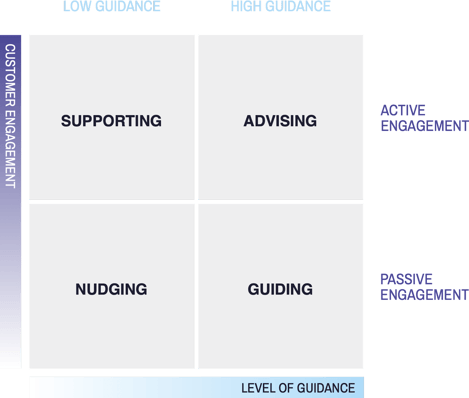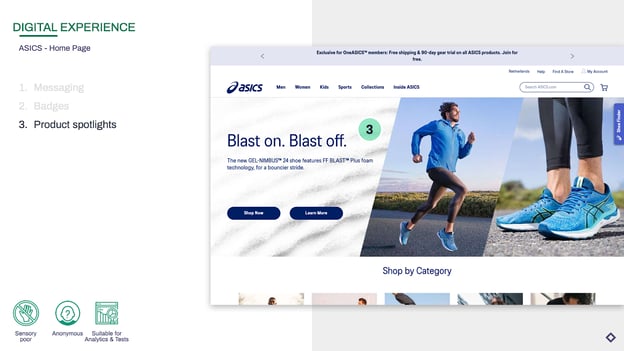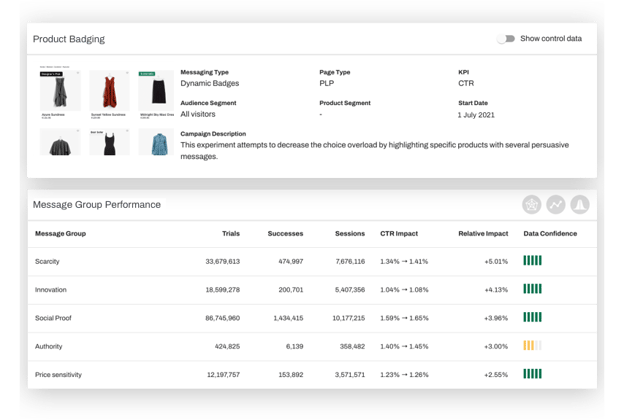Learn how to drive purchase behavior both in-store and offline with the guided selling experience!

Learn how to drive purchase behavior both in-store and offline with the guided selling experience!
How do you bring your in-store experience online?
This is a challenge many retailers are experiencing, especially since:
But as you may have noticed, the traditional divide between in-store and online is slowly dissipating.
Instead, retailers are finding ways to bring their in-store experience online – and vice versa.
In Crobox’s webinar, we took to the stage to unpack this challenge. By looking at the theory behind guided selling, we also learned from eCommerce pros how they drive shopping behavior from in-store to online.
With the insights from eCommerce managers from Love Stories and ASICS, we unpacked how to bridge the bricks-to-clicks gap.
Check out the full webinar to see how this all played it out in action. But for a deeper look at guided selling, this article will take you through:
Guided selling is the process of guiding, advising, and nudging customers through their buying journeys and marketing funnels.
The guided selling experience is how you can support your customers in making purchasing decisions that best first their needs and goals.
When we zoom in a little deeper into guided selling there are three overlapping factors you should always consider when leveraging a guided selling experience.
This is a framework up by our in-house behavior expert. With experience working in eCommerce, he has a holistic view to see guided selling from both the consumer’s perspective and the brand. To learn more about our guided selling pro – check out Joris’ employee spotlight.


The environment is the foundation of your guided selling experience. Naturally, behavior will change depending on which channel your shoppers are carrying out their purchases.
For example, we can all agree that online and in-store shopping behavior will look very different, right?
But so will shopping on mobile, through social channels, or even if someone is carrying out a click-and-collect purchase.
Where is the guided selling experience taking place? This is the first important thing to consider.
2. Customer

Next to this is maybe the most obvious one: Your customer’s shopping state will very much influence your guided selling strategy.
Are they a high-needs shopper? Or maybe just browsing.
Both kinds of customers will have very different expectations when it comes to guided selling. Your shopper’s level of motivation and attention will also differ per individual.
One example our behavioral expert Joris mentions is going shopping with a one-year-old. This usually draws attention away from the experience, no matter where you’re shopping.

The goal of implementing a guided selling experience is, ultimately, to match your customers to relevant products made for them.
Products play their own part in this framework, including the products’ messages, attributes, and how you promote these across your channels.
Too many products might induce choice overload. Too few might influence your product visibility. And without guiding the sale, your product’s findability will be harder to conquer.
“[At Love Stories], we sell a product that sits directly on your skin, so it has to feel good. With a shoe or pair of jeans, you might be a bit more forgiving, so this is critical for us. Aside from the haptics, I personally believe the difference is that online shopping is way more recreational than physical, in-store shopping.” - Claudia Moron, eCommerce Manager at Love Stories
Now that you have the factors involved, let’s take a look at the framework behind plotting a guided selling experience.

Your goal is to prompt purchase behavior in a way that leaves the customer satisfied. And, hopefully, coming back for more.
Which means there are two things to consider before leveraging one of these guided selling techniques:
Your shoppers can either be actively or passively engaged. In other words, do they have a shopping goal? Or are they just here to check out your brand?
The motivation behind the shopping intent will show you what level of guidance your shoppers need to complete their goals.
For instance, if your customer is looking for some much-needed retail therapy after a big pay-check, all they might need are implicit cues to nudge them along their journey.
But if they’re looking for a Valentine’s Day gift for their partner, they already have a clear goal in mind. Here, you should facilitate this goal with high guidance.
Keeping this framework in mind, we’re going to look at the difference between an approach that leverages implicit cues and one that should have more high guidance.
In other words, how to apply these guided selling experienced throughout the buying journey:

Nudges are implicit cues that drive behavior. They are small changes to the so-called ‘choice architecture’ that act as prompts to facilitate decision-making.
There’s a lot of behavioral theory behind these small nudges. We’ve actually written a whole ebook about it!
So what do nudges look like in-store? And how can you implement nudges in the eCommerce environment?
Let’s take a look at the ASICS guided selling experience. For more on how they’ve taken this experience online, read our case study.

Remember, the main difference between in-store and online is that in-store is a sensory-rich experience.
How do we make this guided selling experience more robust, keeping in mind your shoppers can’t touch or smell your products?



You can test different kinds of behavioral nudges to see what messages work and for who. At Crobox, we actually auto-optimize the messages people see in order to drive purchase decision-making behavior in a more relevant way.
Based on the principles of nudging, we can personalize the guided selling experience and take your messaging to whole new levels. For a more long-form article on how this works, check out our Dynamic Messaging blog post.
To learn more about how Crobox uses these messages, check out our Dynamic Messaging platform.
“This is what we try to do at Crobox: Offer the right information so that we are funneling people to the right kinds of products. These implicit cues can actually guide the shopper in a subconscious way, because most of the time while shopping online we aren’t in a ‘conscious’ scrolling state. These small nudges can therefore be quite powerful to aid decision-making.” - Joris Fonteijn, Chief Product Officer at Crobox
“The number one tool for us [ASICS] is the Running Shoe Finder. It’s currently involved in more than 20% of our total eCommerce revenue.” - Rick Hoving, eCommerce Manager at ASICS
Nudging is a passive way to leverage the guided selling experience for your shoppers. Now let’s take a look at how to guide, advise, and support your more ‘active’ shoppers.
These different guided selling techniques are only the tip of the iceberg. Plenty guided selling tools, which you can see at work in our guided selling handbook (download it at the end of this article!).
But to start, let’s see what these look like from in-store to online.
“As digital commerce experts, we have to make sure that our messaging is even sharper online and we put the right product in front of the consumer even faster. Guided selling tools and even nudging and all those little things that bring the consumer to click on the right product become more important for us.” - Claudia Moron, eCommerce Manager at Love Stories

In-store product advisors will be your sales clerks. These are people you can count on to recommend products based on what your shoppers are looking for.
Sales clerks can also help shoppers:
“What you can recreate online is the experience to guide people, but with the right kind of content. The consistency of what you can show online, and the backup information we can add to every product, makes it easier to compare products online.” - Rick Hoving, eCommerce Manager at ASICS
Bringing the concept of a human sales clerk to the eCommerce environment may not always seem so fool-proof.
But equipped with these tools you can actually bring the human back online – while guiding your customers to the products made for them.
Product Finders
You can bring your sales clerks online by leveraging a product finder (on your homepage or product pages – ideally all pages, if it’s discreet enough not to interrupt the buying experience!).
Take Love Stories’ product finder. This is great to leverage for shoppers at the start of their buying journeys (but works just as well for shoppers looking for help to find a specific product).
By asking their shoppers a series of questions to determine their bra size and overall lingerie style preferences, Love Stories can recommend the perfect bralette to their shoppers.
In short, this recreates the in-store sales clerk by:
“Love Stories has the benefit of having a fairly small collection. So what we’re doing is actually trying on every single item that we’re selling with different body shapes. We really stress-test the product to see the best ways to guide the consumer in finding the best product, from how it fits to how it feels.” - Claudia Moron, eCommerce Manager at Love Stories
Product Recommenders

Your detail page is a great place to leverage product recommenders. Shoppers are at the stage of their decision-making where their engagement may be low but the level of guidance is high.
Meaning, that it’s a great time if you want to cross or up-sell similar products. But these should be relevant and helpful. Either that or they’ll come across as too pushy or saturate the product page with unnecessary information.
The great thing about product recommenders is how they make your other products visible. Plus, they show your customers that you’re aware of their preferences and want to help them navigate your products better.
Product Comparison

To assist your customers' decision-making when they do finally choose a product, choose a product comparison matrix.
On a behavioral level, this will help to:
“Online, there is an attention deficit. Either you’re watching the Netflix and browsing on your phone, or you’re doing other kinds of multitasking. In-store shopping you have a high commitment but online the drop-off rates are higher.
Online, customers are also confronted with an overload of choices and products. Bringing the guided selling experience online then is first and foremost a question of making sure the right information is available to the customer.” - Joris Fonteijn, CPO at Crobox

Crobox’s product profiles lets retailers analyze the performance of their products.
Online, you can start collecting and leveraging data (from psychographics to behavioral data!).
From shopper search behavior to clicks and purchases, you’ll be able to start unpacking the kind of behavior you wouldn’t normally see in-stores.
For example,
This kind of data will not only be useful for sharper segmentation but also help you make more data-driven decisions.
Including how to merchandise your products better by making a data-driven decision of where to merchandise them.

With data as the crux of your guided selling strategy, this can also help you zoom in on specific click behavior. E.g.,
These are things you can’t measure in-store. Measurability, then, is one of the most significant advantages of online shopping.
“What I really enjoy is the intimacy you have when you buy online. Our product can be very intimidating for women, and many might not feel comfortable getting undressed and trying it on themselves in stores. Of course, we have both types of consumers. But this type of online consumer has, with eCommerce, the opportunity to buy within the comfort of their own four walls.” - Claudia Moron, eCommerce Manager at Love Stories
Many retailers are now seeing the importance of finding a commerce to content approach. It’s not just about pushing products but selling experiences and educating customers about your brand.

Relevant content is key here: Brands can now show the right message at the right time and to the right person.
Another advantage of online shopping is that you can:
But to the right customer segments – something that looks more like a shot in the dark in an offline environment.
In short, you can leverage the right kinds of content to deliver to the right kinds of customers to help them sift through choices and educate them better on your product offering.

Following this, online offers the opportunity to test product attributes and optimize your actual product design.
We’ve talked about merchandising and marketing – hello, manufacturing!
What’s great about online shopping is that you can test different product descriptions and attribute messaging to see what’s appealing to your shoppers.
For example, imagine you’re selling sustainable products.
What kinds of sustainable messaging appeal to your customers? Do they care about transparent supply chains or recycled fabrics more?
This kind of testing can only really be done on-site. And it’s this kind of attribute-rich knowledge that will help you elevate the entire guided selling experience throughout the funnel.
“It’s really important our customers don’t just go to our websites, because they would only see the first two rows of products (on the PLP) and pick the one they like based on taste or color. But that doesn’t mean it’s the right running shoe for you. It’s then really important to use guided selling to find your perfect shoe.” - Rick Hoving, eCommerce Manager at ASICS
Ultimately, you want a personalized experience across multiple touchpoints to facilitate the guided selling experience.
You can experiment with different kinds of guided selling tools on-site, but the real beauty is in how you collect data in the online environment and leverage this in-store.
In the end, the bricks-to-clicks experience should be a continuous feedback loop that is always optimizing based on the environment, customer, and product.